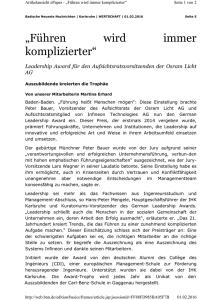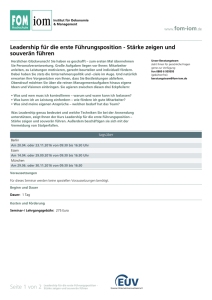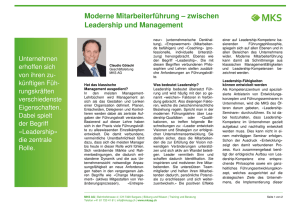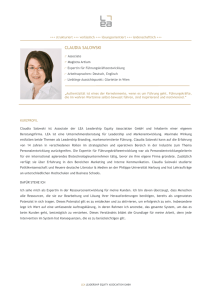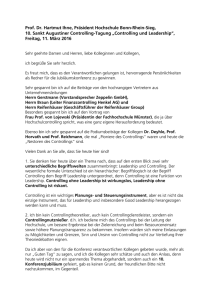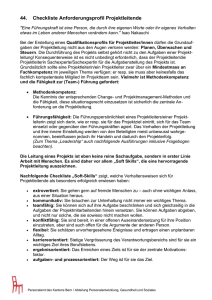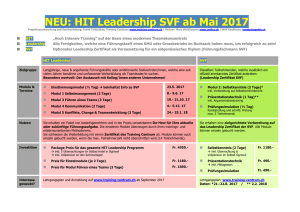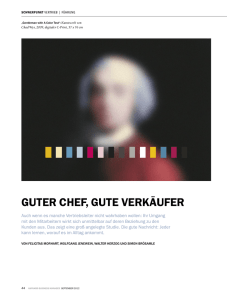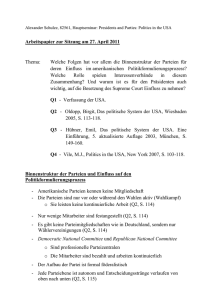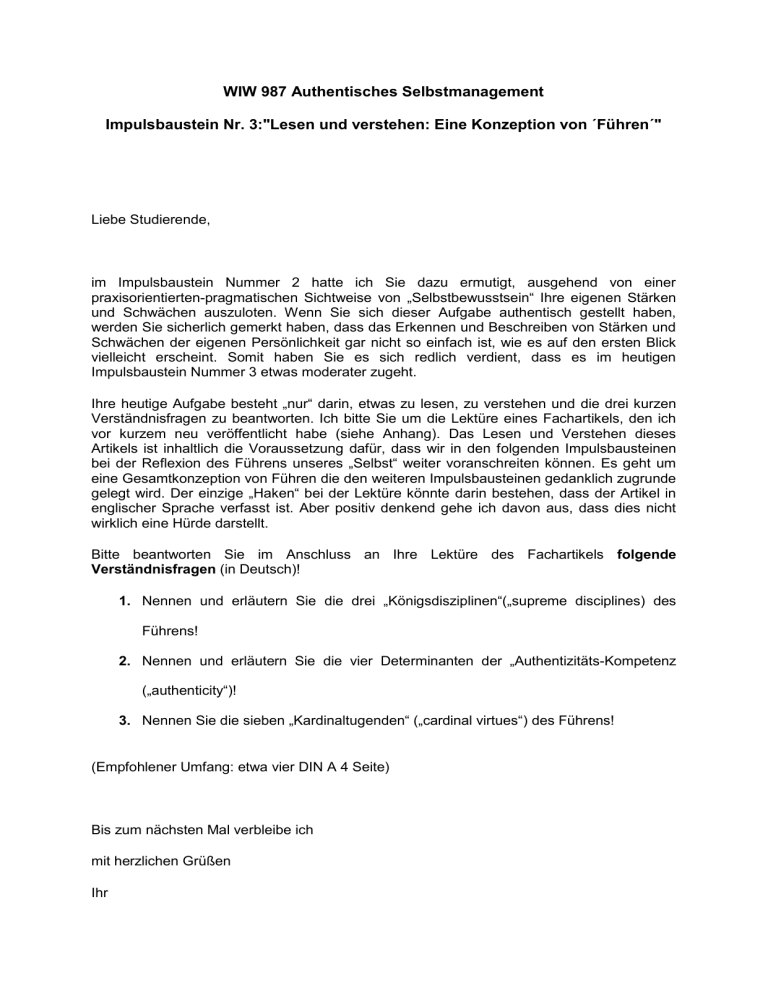
WIW 987 Authentisches Selbstmanagement Impulsbaustein Nr. 3:"Lesen und verstehen: Eine Konzeption von ´Führen´" Liebe Studierende, im Impulsbaustein Nummer 2 hatte ich Sie dazu ermutigt, ausgehend von einer praxisorientierten-pragmatischen Sichtweise von „Selbstbewusstsein“ Ihre eigenen Stärken und Schwächen auszuloten. Wenn Sie sich dieser Aufgabe authentisch gestellt haben, werden Sie sicherlich gemerkt haben, dass das Erkennen und Beschreiben von Stärken und Schwächen der eigenen Persönlichkeit gar nicht so einfach ist, wie es auf den ersten Blick vielleicht erscheint. Somit haben Sie es sich redlich verdient, dass es im heutigen Impulsbaustein Nummer 3 etwas moderater zugeht. Ihre heutige Aufgabe besteht „nur“ darin, etwas zu lesen, zu verstehen und die drei kurzen Verständnisfragen zu beantworten. Ich bitte Sie um die Lektüre eines Fachartikels, den ich vor kurzem neu veröffentlicht habe (siehe Anhang). Das Lesen und Verstehen dieses Artikels ist inhaltlich die Voraussetzung dafür, dass wir in den folgenden Impulsbausteinen bei der Reflexion des Führens unseres „Selbst“ weiter voranschreiten können. Es geht um eine Gesamtkonzeption von Führen die den weiteren Impulsbausteinen gedanklich zugrunde gelegt wird. Der einzige „Haken“ bei der Lektüre könnte darin bestehen, dass der Artikel in englischer Sprache verfasst ist. Aber positiv denkend gehe ich davon aus, dass dies nicht wirklich eine Hürde darstellt. Bitte beantworten Sie im Anschluss an Ihre Lektüre des Fachartikels folgende Verständnisfragen (in Deutsch)! 1. Nennen und erläutern Sie die drei „Königsdisziplinen“(„supreme disciplines) des Führens! 2. Nennen und erläutern Sie die vier Determinanten der „Authentizitäts-Kompetenz („authenticity“)! 3. Nennen Sie die sieben „Kardinaltugenden“ („cardinal virtues“) des Führens! (Empfohlener Umfang: etwa vier DIN A 4 Seite) Bis zum nächsten Mal verbleibe ich mit herzlichen Grüßen Ihr Prof. Dr. Rolf Karbach Rolf Karbach Core Competencies and Virtues of Transformational Leaders _ _ _ _ _ _ _ _ A Conceptual Design Im Original veröffentlicht in: University Review Vol. 4, No. 3/2010: A Kaleidoscope of Business Economics and Technology. Alexander-DubcekUniversity of Trencin, Slovak Republic CORE COMPETENCIES AND VIRTUES OF TRANSFORMATIONAL LEADERS -------------------A CONCEPTUAL DESIGN by Rolf Karbach Abstract “What does leadership mean?” and „How does leadership work?” These two questions have preoccupied scientific management studies for a long time. With the present article I would like to contribute to finding answers to these questions by creating an approach to a conceptual overall design of leadership, based on the research area of transformational leadership. Therefore, the introductory part (part 0) is going to deal with the key message of transformational leadership as we understand it. The two main chapters (parts 1 and 2) contain an action-oriented description of the supreme disciplines of transformational leadership and a behaviour-oriented presentation of the cardinal virtues of transformational leaders. The conclusion (part 3) will outline our approach to an overall concept of transformational leadership and give a final overview of the latter. Key Words Leadership, conceptual competencies, communicative competencies, authenticity, supreme disciplines of leadership, cardinal virtues of leadership, values 0. The key message: “To lead means to move people!“ On our quest for the secret of people-friendly and at the same time successful leadership, it might be a good idea to start consulting a wiser counsel than management science. We think that human history, for instance, can be a wise instructor in regards to leadership. We can get an idea of what real leadership means, if we look at some of the great leaders in history. John F. Kennedy, for instance: With his bold idea of flying to the moon, Kennedy created an enthusiasm among millions of people, which is unique in the history of the 20th century. Or Martin Luther King: With his unforgettable words “I have a dream” he created a vision of a society without segregation of “black” and “white” and paved the way to the abolition of racial discrimination. And finally Mahatma Gandhi: With his sweeping paradigm of passive resistance, which he exemplified through his own life, he managed to intimidate the British colonial rulers and led a whole nation to independence. Bold ideas, unforgettable words and sweeping examples: those are the three poles from which the kind of fascination of great leaders derives, we sometimes call charisma. Kennedy, King, Gandhi and many other great leaders in history have demonstrated excellent leadership skills by creating a suction of fascination, which magically attracted people. To put it in a nutshell: they moved people. “To lead means to move people!” This is the key message of our approach to transformational leadership. The verb “to move” has a double meaning: 1. to emotionally move someone (“that moved me to tears”), 2. to physically move someone (“I have moved from point A to point B”). In order to move people in both ways and therefore lead them, leaders need to ask themselves the following questions: “What do I need to do? What actions do I have to take?” We have called these actions the “supreme disciplines of leadership”, because they are the key to successful and people-friendly leadership. 1. The supreme disciplines of leadership In the scientific approach to transformational leadership, the supreme disciplines of leadership, as we call them, are based on certain competencies all transformational leaders must have. If these competencies are summarized to certain fields of competence, transformational leaders primarily distinguish themselves through conceptual competencies, communicative competencies and authenticity. In this context, we consciously refrain from using academic definitions and continue to strictly focus on the necessary action-oriented point of view of leaders. Therefore, we have transcribed the mentioned fields of competence in table 1 on the different levels according to their didactic equivalents. The idea is to show the original executive functions of transformational leaders in an understandable and therefore slightly exaggerated and simplified way. key message levels „To lead means to move people !“ of didactic illustration simplified central messages original executive functions fields of core competencies based on transformational leadership Table. 1: “Move people with bold ideas!“ “Move people with unforgettable words!“ „”Move people by being a sweeping example!“ Executive function 1. :: Executive function 2: Executive function 3 : Think ahead! Communicate ideas of Be an authentic example of your ideas for the the future to all people future! involved! conceptual competencies of transformational leadership communicative competencies of transformational leadership authenticity in transformational leadership Research based fields of core competencies of transformational leadership and their equivalents on the different levels of didactic illustration Now, let us have a closer look at the individual supreme disciplines of leadership. The first of those disciplines is the executive task of thinking ahead. Table 2 shows some corresponding approaches to action-orientation: FIRST SUPREME DISCIPLINE OF LEADERSHIP Move people with bold ideas! In order to do so, it is your executive task to think ahead by: formulating an inspiring mission, deriving clear objectives from this mission, developing suitable strategies in order to meet those objectives, and finally by outlining ways of implementation of those strategies through operational action. (‘conceptual competence’) („Konzeptionelle Kompetenz“) Table. 2: Action-oriented description of ‘conceptual competence’ of transformational leadership. In order to cope with the executive function of ‘thinking ahead’ as well as with the functions of the other two supreme competencies of leadership, management science offers a number of relevant tools and instruments. Once more we consciously avoid quoting the usual management theories and training tactics of many institutions for management training, which often misinterpret leadership as the sheer application of management ‘techniques’. The concept of transformational leadership, however, is dedicated to the inner attitude leaders should have in regards to their executive functions. We would therefore like to give a thought-provoking example for each of the supreme disciplines of leadership, in order to exemplarily reflect the inner attitude of the leader towards the respective executive function. Our example for the first supreme discipline of leadership is the following: We ask you, dear reader, why you are doing what you are doing right now (in this case reading this article)? Maybe your answer is: “The weather is rather nasty today and I just happened to come across this article.” Or if you are a student, your answer might be: “I have to read this article, whether I like it or not, because my professor told me so.” You will certainly have noticed that these answers are rather ‘suboptimal’. The inner attitude of a transformational leader can lead him to only one possible answer: “I am reading this article, because my current operational action (reading the article) is the logical consequence of superordinate strategies, objectives, and an attractive mission!” You should therefore check stringently in how far your mission as a leader can be ‘broken down to’ objectives, strategies and operational action. It must be part of your inner attitude as a transformational leader that your mission is reflected in even the smallest part of ‘ordinary day-to-day business’. Table 3 is going to explain the second supreme discipline of leadership, which is the executive function of communicating ideas for the future to the people involved. The starting points for practical orientation will reflect different communicational situations, since there are instrumental differences as well as differences in regards to the inner attitude of leaders when they address people in the protected atmosphere of a oneto-one conversation, in a small team or in front of a larger audience; especially in the particular case of conflict communication. SECOND SUPREME DISCIPLINE OF LEADERSHIP “Move people with your unforgettable words!“ In order to do so, it is your executive task to communicate your ideas of the future to all people involved by: communication with people in a one-to-one conversation, communication with people in a team, communication with people in front of a larger audience, and if necessary, also by active conflict communication with the above mentioned target groups. (‘communicative competence’) Abb. 3: Action oriented description of “communicative competence“ of transformational leadership. Our thought-provoking example for the second supreme discipline of leadership is the following: Please imagine you are coming home from work one evening and your wife/husband/partner surprises you with a special three course dinner he/she has prepared for you. The table is beautifully set, you sit down and the first course, a soup, is served. You take the first spoonful and ask: “What is the green herb?”, and your partner snaps at you: “If you don’t like my food you are welcome to go out and have your dinner somewhere else.” (We owe this humorous, classical example of failed communication F. Schulz von Thun; please see bibliography). Here we see, that communication does not simply mean ‘to talk to each other’. Apart from the obvious objective level, communication also takes place on subtle interpersonal, selfrevealing and appellative levels. The inner attitude of a transformational leader should, at this point, be driven by empathy and a high degree of readiness to continuously and critically reflect his/her own communication-psychological behavior. The third supreme discipline demonstrates that a transformational leader has to exemplify his/her ideas of the future credibly, which means with authenticity, in order to move people (Please see table 4). THIRD SUPREME DISCIPLINE OF LEADERSHIP “Move people by being an authentic example for your ideas of the future!“ In order to do so, it is your executive task to exemplify your ideas of the future by taking on an attitude which is guided by: the spiritedness, the dramaturgy, the authority and finally a good portion of lunacy and nuttiness of/in your operational actions. (‘authenticity’) Table 4: Action oriented description of ‚authenticity competence’ of transformational leadership. Our thought-provoking suggestion for the third supreme discipline of leadership is the following: Double-check the key words of this supreme discipline for their deeper meaning. ‘Spiritedness’ carries the words ‘spirit’ and ‘inspiration’. What do we associate with a leader who is able to ‘inspire’ his/her staff? The term ‘dramaturgy’ will probably remind us first and foremost of the theatre. What comes to your mind when you think about a theatre performance? Maybe you are thinking of the plays ‘development of tension’, its ‘cast’ or the ‘stage design’? What would all this mean in regards to the implementation of operational action? The term ‘authority’ does always have a double meaning, which can most appropriately be described with the phrase ‘As leaders we should have authority without being authoritarian’. But how can we as leaders gain (positive) authority without being dependent on (negative) authoritarian behavior? And finally the terms lunacy and nuttiness, two words apparently completely out of place, which we have consciously chosen for exactly that matter. A leader who is nutty and therefore out of place, in the widest sense of the word, has left his/her original position and taken on a new perspective. He/she is therefore literally out of place. But in how far is this change of position important and necessary for a leader? What does it mean for the suction of fascination a leader has to display in order to move their staff to join in and follow them to their new position? All these are questions which can inspire reflection of the inner attitude of transformational leaders in regards to the third supreme discipline, and which can already be drawn from the above mentioned associations. After the conceptual lining out of the supreme disciplines of leadership, let us quickly check whether or not our conceptual design of transformational leadership is comprehensive enough for moving people the way we described it in our key message. Therefore, we are going to look at two ‘top leaders’ and examine, if they are principally able to act in accordance with the above mentioned core competencies we are expecting of transformational leaders. The two ‘top leaders’ are a marriage swindler and a mafia boss. Are these two driven by ‘bold ideas’ in a sense that their operational actions are clearly oriented towards superordinate missions, objectives and strategies? Are they capable of target-oriented communication? Are their actions characterized by spiritedness, authority and dramaturgy? No doubt the answer to all these questions would be a clear ‘yes’. However, we would never seriously consider suggesting them to any hall of fame, so to speak as role models due to their extraordinary leadership qualities. Consequently, our overall concept is still not complete and lacks an essential component of successful and people-friendly transformational leadership. 2. The cardinal virtues of leadership Even though the marriage swindler and the mafia boss have so far both been acting according to all core competencies of our conception, we are still bothered by the fact that they are not ‘doing good’. The question of ‘the good’ and ‘the bad’ has moved people and the history of mankind since the very beginning. Particularly the sciences of philosophy and theology have dedicated themselves to this topic for over 2.500 years and additionally have led a seemingly indefinite discussion on the ‘values’ of human behavior. The fundamental idea of this discussion is that there are certain values which are of universal significance; in other words which are practically valid for all people all over the world. In this context, philosophy defines a ‘virtue’ as the ability or power to act in accordance with those universal values. ‘Cardinal virtues’ consequently apply to those values which are considered to be of particular importance. The approach of transformational leadership recently postulates to declare cardinal virtues the basis of all executive actions. Table 5 shows, in an action-oriented description, the respective executive function. The seven cardinal virtues of table 5 reflect those virtues, which in philosophy and theology have been and still are considered the main virtues - in spite of long lasting controversial discussions, some of which have even lasted for several centuries. Therefore it seems only sensible to me to include them in the overall conception of transformational leadership. THE SEVEN CARDINAL VIRTUES OF LEADERSHIP „Move people by your power to act in accordance with the important values!“ Therefore it is your executive task to take on an inner attitude which enables you to ‘do good’, in the sense of the universally valid canon of values of humanness, while performing the supreme disciplines of leadership with enthusiasm (that is to say with ease and joyfully). In order to do so, exercise yourself in the cardinal virtues of: fortitude prudence justice cardinal virtues of philosophy temperance faith hope cardinal virtues of theology love Table 5: Action-oriented description of the cardinal virtues of transformational leadership. We would also like to give an example for the cardinal virtues of transformational leadership, as we have done it with the supreme disciplines, in order to stimulate reflection on the inner attitude of transformational leaders: Our experiences gained from management training courses of the last 25 years have strengthened our belief that virtues are far more important in regards to leading people than leadership techniques or skills. Skills are abilities which have been acquired and can or cannot be applied when needed. In contrast to skills, virtues are imperative. Whoever has them has no choice but acting in accordance with them. A virtue cannot be put aside like a musical instrument you just do not want to play anymore. Virtues can also not be acquired in an ad hoc manner during a short term seminar, as many trainers ballyhoo with slogans like ‘learn to lead in three days’. Virtues go hand in hand with personal development. In contrast to leadership techniques, virtues are a characteristic of what we call the art of leading, and in regards to our approach, we feel obliged to this art. Thus, supreme disciplines and cardinal virtues finally build the conceptual framework for our approach to an overall concept of transformational leadership. 3. Conclusion: Approach to an overall concept of transformational leadership To lead in the sense of ’moving people’ requires certain leadership actions and taking on a certain leadership behaviour. This is the key message of our approach to an overall concept of transformational leadership. Transformational leadership actions are reflected in the supreme disciplines of leadership and are determined by the simplified question of ‘What do I need to do?’ Transformational leadership behaviour is expressed by the cardinal virtues of leadership (In simple words: ‘How shall I behave?’). Table 6 gives a final overview of the respective action- and behaviouroriented approaches. key message To lead means to move people! Think ahead. supreme disciplines of leadership approaches for practical orientation (‘What do I need to do?’) Communicate ideas of the future to all people involved. one-to-one in a team to a larger audience mission objective strategies operational action Be an authentic example of your ideas for the future. spiritedness dramaturgy authority lunacy&nuttiness if necessary: conflict communication be an example produce approaches for practical oprientation (‘How shall I behave?’) cardinal virtues of leadership Table 6: fortitude prudence temperanc e cardinal virtues of philosophy justice faith love cardinal virtues of theology Overview of a conceptual design of transformational leadership hope Bibliography 1.) R. Egger, Mut. Kardinaltugend der Menschenführung. Zürich 2007 2.) D. Goleman, Social Intelligence: the New Science of Human Relationship. New York 2006 3.) A. Grün, Menschen führen – Leben wecken. München 2006 4.) M. Hughes, L. Patterson, J. Terell, Emotional Intelligence in Action: Training and Coaching Activities for Leaders and Managers. San Francisco 2005 5.) J. Kouzes, B. Posner, The Leadership Challenge. San Francisco 2007 6.) J. Naisbitt, Mindset: Reset your Thinking and See the Future. New York 2006 7.) F. Schulz von Thun, Miteinander reden. Allgemeine Psychologie der Kommunikation. 1.Aufl. Reinbek bei Hamburg 1981 8.) H. Strunz, M. Dorsch, Management. München/Wien 2001 9.) R. Wunderer, Führung und Zusammenarbeit. Eine unternehmerische Führungslehre. München/Neuwied 2003 10.) G. Yukl, Leadership on Organizations. New York 2002
